LLB101 - Introduction to Law: Precedent & Court Hierarchy Analysis
VerifiedAdded on 2023/03/30
|7
|1102
|404
Homework Assignment
AI Summary
This assignment delves into the doctrine of precedent and court hierarchy within the context of an Introduction to Law course (LLB101). It addresses questions related to the binding nature of court decisions, particularly concerning the Privy Council's influence on Australian courts before and after 1986, and the applicability of decisions from different court hierarchies. The assignment also discusses the role of judges in law-making, exploring how statutory and constitutional interpretations contribute to legal evolution, while also considering the constraints on judicial law-making, such as the principle of stare decisis. It concludes by acknowledging the common law's adaptability to societal needs and the challenges judges face in weighing different policies and values.
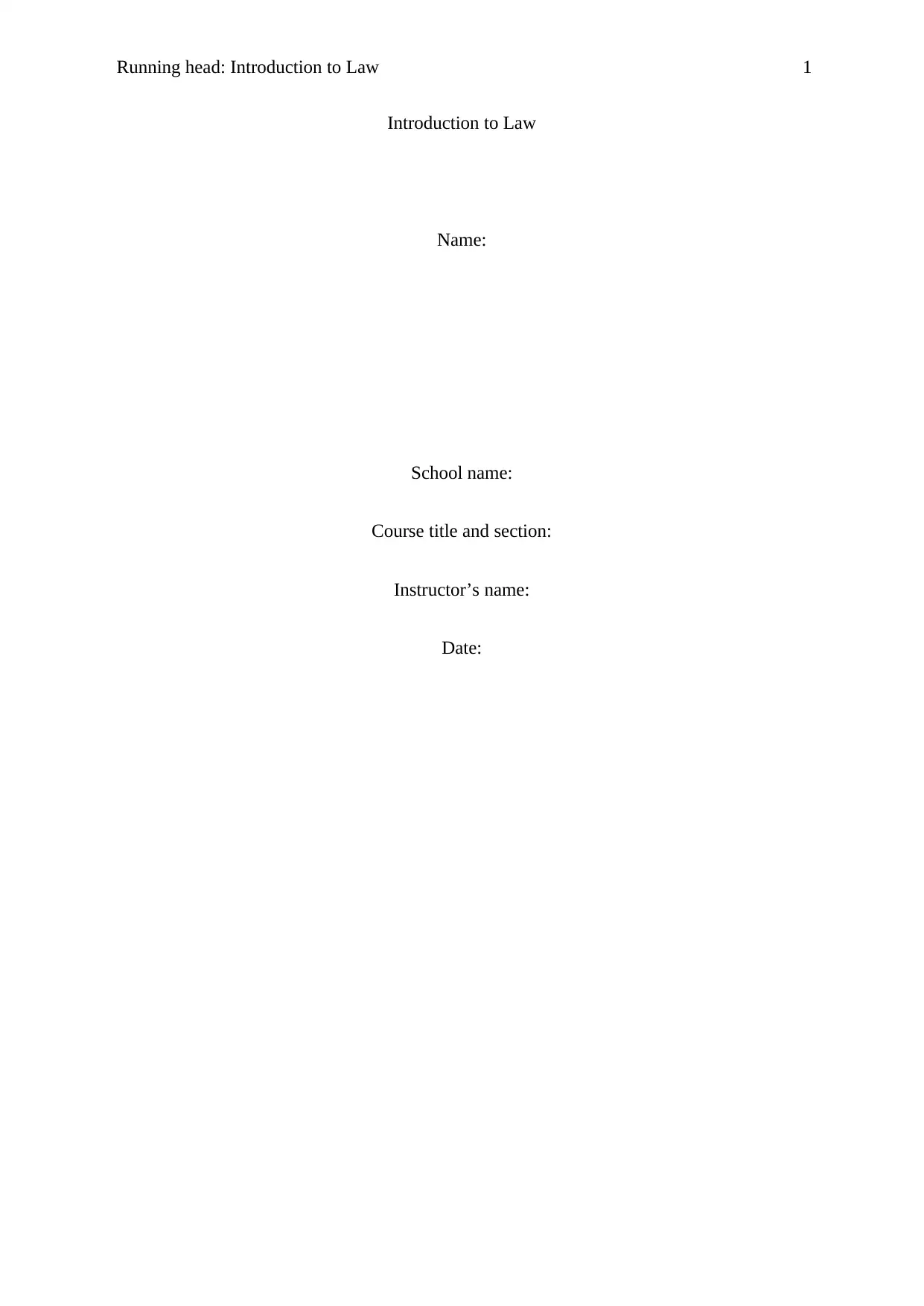
Running head: Introduction to Law 1
Introduction to Law
Name:
School name:
Course title and section:
Instructor’s name:
Date:
Introduction to Law
Name:
School name:
Course title and section:
Instructor’s name:
Date:
Paraphrase This Document
Need a fresh take? Get an instant paraphrase of this document with our AI Paraphraser
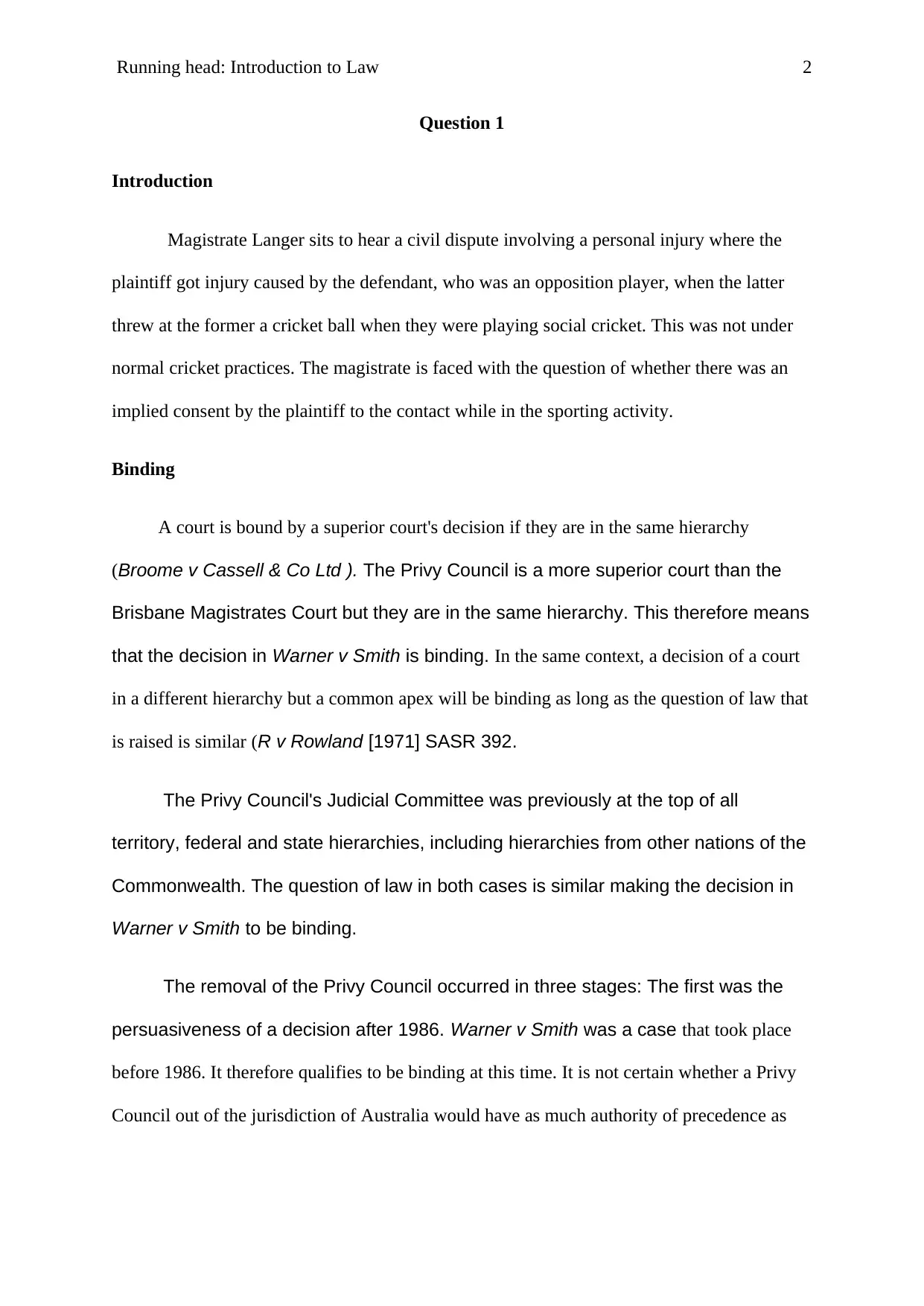
Running head: Introduction to Law 2
Question 1
Introduction
Magistrate Langer sits to hear a civil dispute involving a personal injury where the
plaintiff got injury caused by the defendant, who was an opposition player, when the latter
threw at the former a cricket ball when they were playing social cricket. This was not under
normal cricket practices. The magistrate is faced with the question of whether there was an
implied consent by the plaintiff to the contact while in the sporting activity.
Binding
A court is bound by a superior court's decision if they are in the same hierarchy
(Broome v Cassell & Co Ltd ). The Privy Council is a more superior court than the
Brisbane Magistrates Court but they are in the same hierarchy. This therefore means
that the decision in Warner v Smith is binding. In the same context, a decision of a court
in a different hierarchy but a common apex will be binding as long as the question of law that
is raised is similar (R v Rowland [1971] SASR 392.
The Privy Council's Judicial Committee was previously at the top of all
territory, federal and state hierarchies, including hierarchies from other nations of the
Commonwealth. The question of law in both cases is similar making the decision in
Warner v Smith to be binding.
The removal of the Privy Council occurred in three stages: The first was the
persuasiveness of a decision after 1986. Warner v Smith was a case that took place
before 1986. It therefore qualifies to be binding at this time. It is not certain whether a Privy
Council out of the jurisdiction of Australia would have as much authority of precedence as
Question 1
Introduction
Magistrate Langer sits to hear a civil dispute involving a personal injury where the
plaintiff got injury caused by the defendant, who was an opposition player, when the latter
threw at the former a cricket ball when they were playing social cricket. This was not under
normal cricket practices. The magistrate is faced with the question of whether there was an
implied consent by the plaintiff to the contact while in the sporting activity.
Binding
A court is bound by a superior court's decision if they are in the same hierarchy
(Broome v Cassell & Co Ltd ). The Privy Council is a more superior court than the
Brisbane Magistrates Court but they are in the same hierarchy. This therefore means
that the decision in Warner v Smith is binding. In the same context, a decision of a court
in a different hierarchy but a common apex will be binding as long as the question of law that
is raised is similar (R v Rowland [1971] SASR 392.
The Privy Council's Judicial Committee was previously at the top of all
territory, federal and state hierarchies, including hierarchies from other nations of the
Commonwealth. The question of law in both cases is similar making the decision in
Warner v Smith to be binding.
The removal of the Privy Council occurred in three stages: The first was the
persuasiveness of a decision after 1986. Warner v Smith was a case that took place
before 1986. It therefore qualifies to be binding at this time. It is not certain whether a Privy
Council out of the jurisdiction of Australia would have as much authority of precedence as
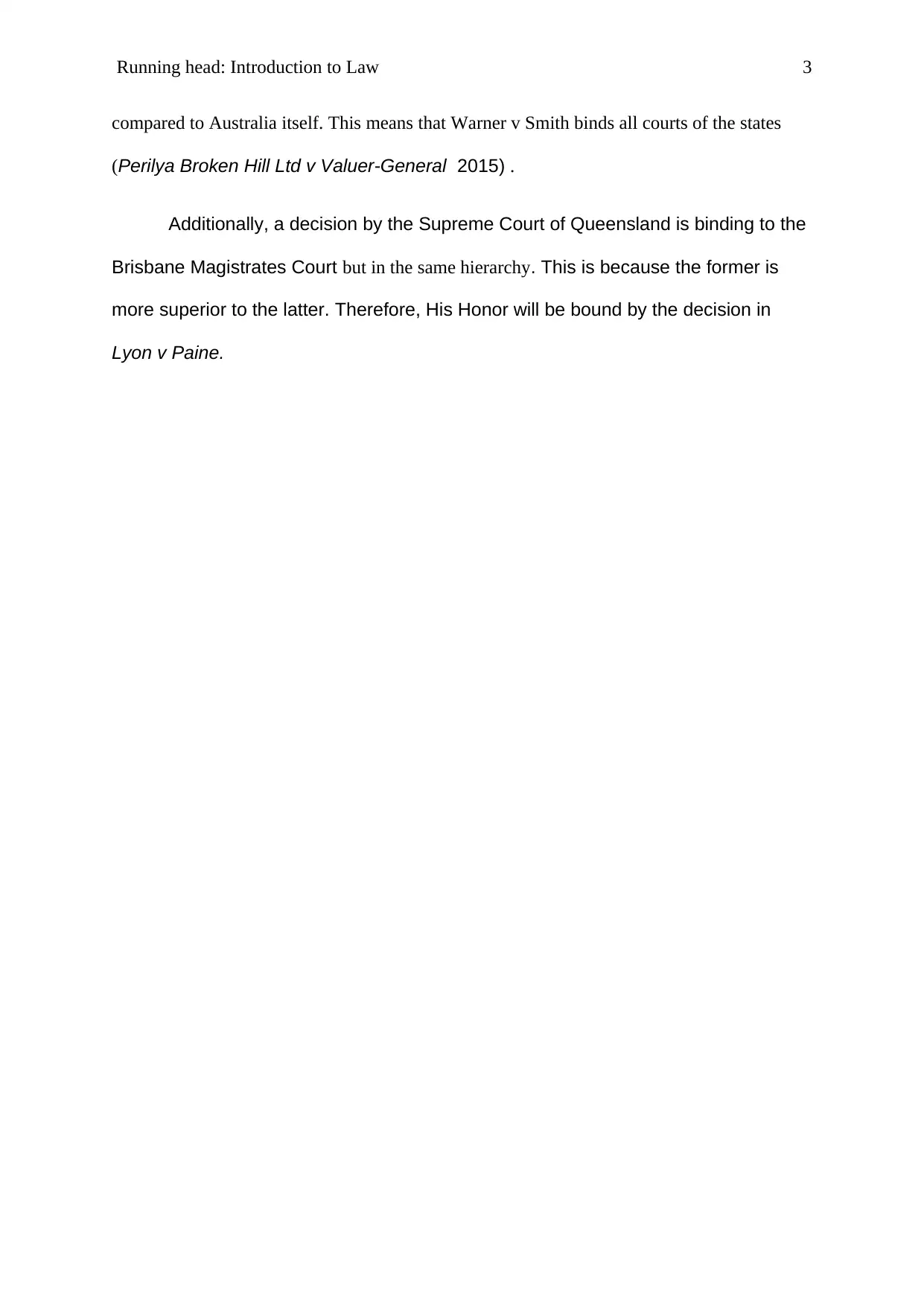
Running head: Introduction to Law 3
compared to Australia itself. This means that Warner v Smith binds all courts of the states
(Perilya Broken Hill Ltd v Valuer-General 2015) .
Additionally, a decision by the Supreme Court of Queensland is binding to the
Brisbane Magistrates Court but in the same hierarchy. This is because the former is
more superior to the latter. Therefore, His Honor will be bound by the decision in
Lyon v Paine.
compared to Australia itself. This means that Warner v Smith binds all courts of the states
(Perilya Broken Hill Ltd v Valuer-General 2015) .
Additionally, a decision by the Supreme Court of Queensland is binding to the
Brisbane Magistrates Court but in the same hierarchy. This is because the former is
more superior to the latter. Therefore, His Honor will be bound by the decision in
Lyon v Paine.
⊘ This is a preview!⊘
Do you want full access?
Subscribe today to unlock all pages.

Trusted by 1+ million students worldwide
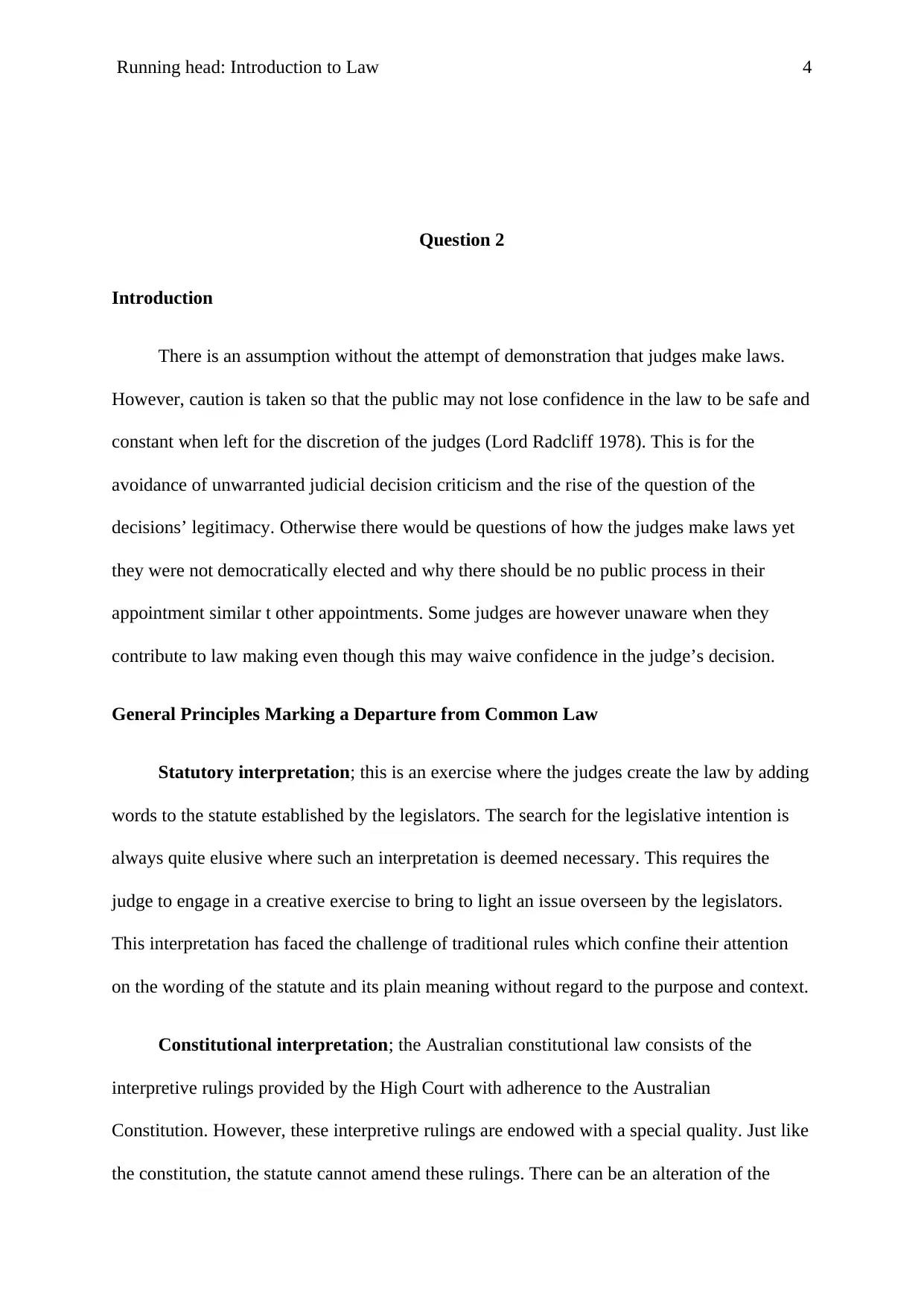
Running head: Introduction to Law 4
Question 2
Introduction
There is an assumption without the attempt of demonstration that judges make laws.
However, caution is taken so that the public may not lose confidence in the law to be safe and
constant when left for the discretion of the judges (Lord Radcliff 1978). This is for the
avoidance of unwarranted judicial decision criticism and the rise of the question of the
decisions’ legitimacy. Otherwise there would be questions of how the judges make laws yet
they were not democratically elected and why there should be no public process in their
appointment similar t other appointments. Some judges are however unaware when they
contribute to law making even though this may waive confidence in the judge’s decision.
General Principles Marking a Departure from Common Law
Statutory interpretation; this is an exercise where the judges create the law by adding
words to the statute established by the legislators. The search for the legislative intention is
always quite elusive where such an interpretation is deemed necessary. This requires the
judge to engage in a creative exercise to bring to light an issue overseen by the legislators.
This interpretation has faced the challenge of traditional rules which confine their attention
on the wording of the statute and its plain meaning without regard to the purpose and context.
Constitutional interpretation; the Australian constitutional law consists of the
interpretive rulings provided by the High Court with adherence to the Australian
Constitution. However, these interpretive rulings are endowed with a special quality. Just like
the constitution, the statute cannot amend these rulings. There can be an alteration of the
Question 2
Introduction
There is an assumption without the attempt of demonstration that judges make laws.
However, caution is taken so that the public may not lose confidence in the law to be safe and
constant when left for the discretion of the judges (Lord Radcliff 1978). This is for the
avoidance of unwarranted judicial decision criticism and the rise of the question of the
decisions’ legitimacy. Otherwise there would be questions of how the judges make laws yet
they were not democratically elected and why there should be no public process in their
appointment similar t other appointments. Some judges are however unaware when they
contribute to law making even though this may waive confidence in the judge’s decision.
General Principles Marking a Departure from Common Law
Statutory interpretation; this is an exercise where the judges create the law by adding
words to the statute established by the legislators. The search for the legislative intention is
always quite elusive where such an interpretation is deemed necessary. This requires the
judge to engage in a creative exercise to bring to light an issue overseen by the legislators.
This interpretation has faced the challenge of traditional rules which confine their attention
on the wording of the statute and its plain meaning without regard to the purpose and context.
Constitutional interpretation; the Australian constitutional law consists of the
interpretive rulings provided by the High Court with adherence to the Australian
Constitution. However, these interpretive rulings are endowed with a special quality. Just like
the constitution, the statute cannot amend these rulings. There can be an alteration of the
Paraphrase This Document
Need a fresh take? Get an instant paraphrase of this document with our AI Paraphraser
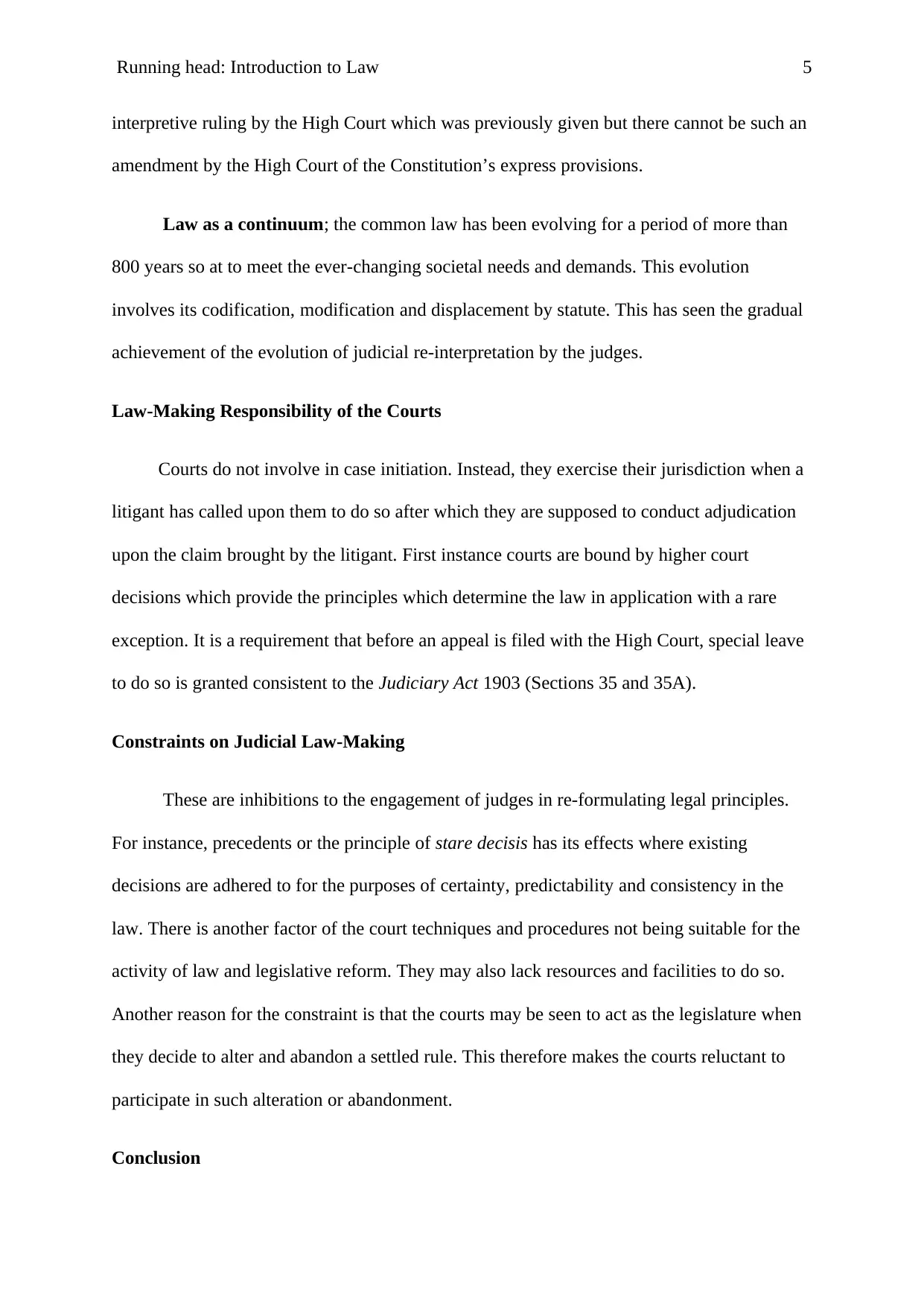
Running head: Introduction to Law 5
interpretive ruling by the High Court which was previously given but there cannot be such an
amendment by the High Court of the Constitution’s express provisions.
Law as a continuum; the common law has been evolving for a period of more than
800 years so at to meet the ever-changing societal needs and demands. This evolution
involves its codification, modification and displacement by statute. This has seen the gradual
achievement of the evolution of judicial re-interpretation by the judges.
Law-Making Responsibility of the Courts
Courts do not involve in case initiation. Instead, they exercise their jurisdiction when a
litigant has called upon them to do so after which they are supposed to conduct adjudication
upon the claim brought by the litigant. First instance courts are bound by higher court
decisions which provide the principles which determine the law in application with a rare
exception. It is a requirement that before an appeal is filed with the High Court, special leave
to do so is granted consistent to the Judiciary Act 1903 (Sections 35 and 35A).
Constraints on Judicial Law-Making
These are inhibitions to the engagement of judges in re-formulating legal principles.
For instance, precedents or the principle of stare decisis has its effects where existing
decisions are adhered to for the purposes of certainty, predictability and consistency in the
law. There is another factor of the court techniques and procedures not being suitable for the
activity of law and legislative reform. They may also lack resources and facilities to do so.
Another reason for the constraint is that the courts may be seen to act as the legislature when
they decide to alter and abandon a settled rule. This therefore makes the courts reluctant to
participate in such alteration or abandonment.
Conclusion
interpretive ruling by the High Court which was previously given but there cannot be such an
amendment by the High Court of the Constitution’s express provisions.
Law as a continuum; the common law has been evolving for a period of more than
800 years so at to meet the ever-changing societal needs and demands. This evolution
involves its codification, modification and displacement by statute. This has seen the gradual
achievement of the evolution of judicial re-interpretation by the judges.
Law-Making Responsibility of the Courts
Courts do not involve in case initiation. Instead, they exercise their jurisdiction when a
litigant has called upon them to do so after which they are supposed to conduct adjudication
upon the claim brought by the litigant. First instance courts are bound by higher court
decisions which provide the principles which determine the law in application with a rare
exception. It is a requirement that before an appeal is filed with the High Court, special leave
to do so is granted consistent to the Judiciary Act 1903 (Sections 35 and 35A).
Constraints on Judicial Law-Making
These are inhibitions to the engagement of judges in re-formulating legal principles.
For instance, precedents or the principle of stare decisis has its effects where existing
decisions are adhered to for the purposes of certainty, predictability and consistency in the
law. There is another factor of the court techniques and procedures not being suitable for the
activity of law and legislative reform. They may also lack resources and facilities to do so.
Another reason for the constraint is that the courts may be seen to act as the legislature when
they decide to alter and abandon a settled rule. This therefore makes the courts reluctant to
participate in such alteration or abandonment.
Conclusion
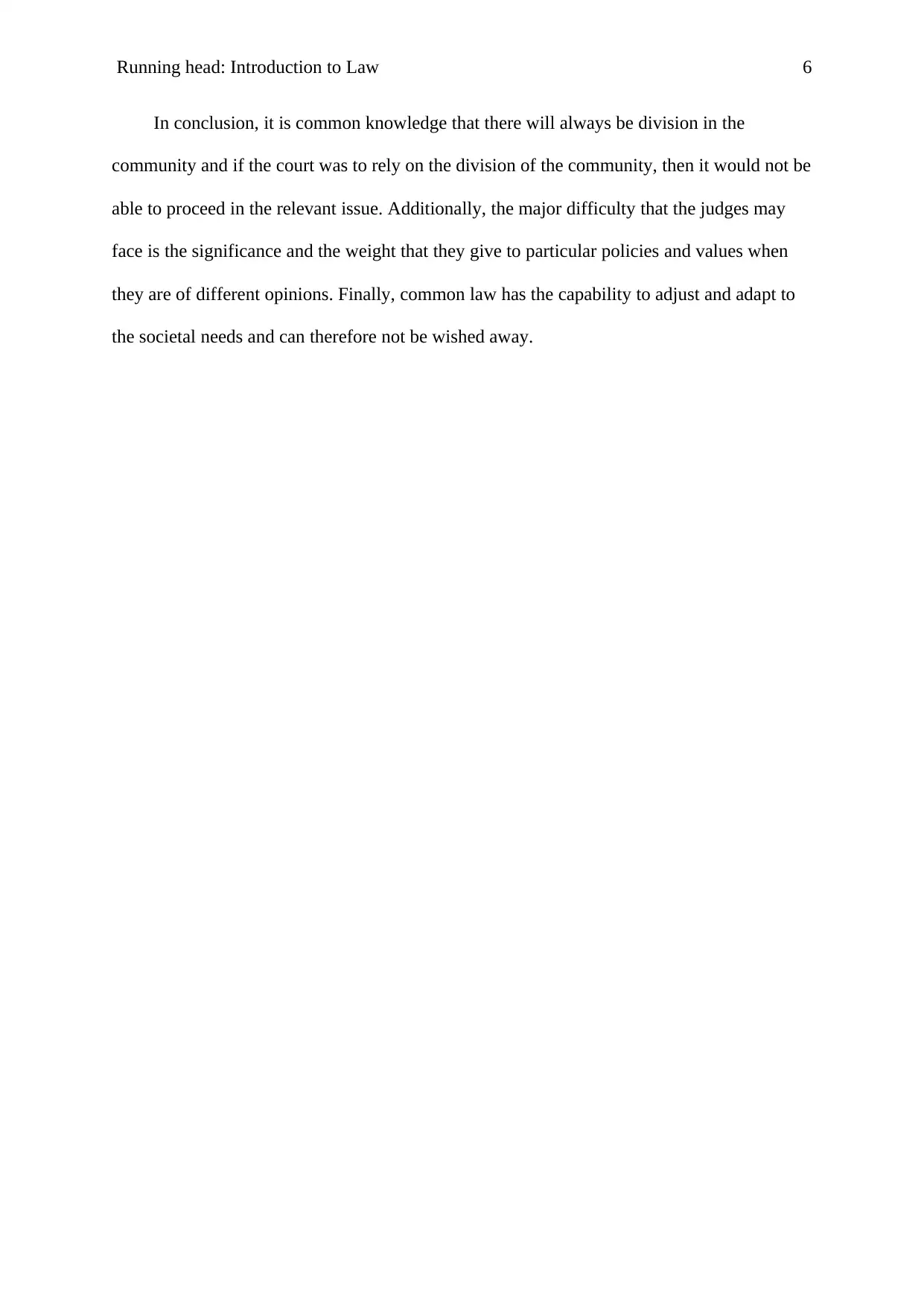
Running head: Introduction to Law 6
In conclusion, it is common knowledge that there will always be division in the
community and if the court was to rely on the division of the community, then it would not be
able to proceed in the relevant issue. Additionally, the major difficulty that the judges may
face is the significance and the weight that they give to particular policies and values when
they are of different opinions. Finally, common law has the capability to adjust and adapt to
the societal needs and can therefore not be wished away.
In conclusion, it is common knowledge that there will always be division in the
community and if the court was to rely on the division of the community, then it would not be
able to proceed in the relevant issue. Additionally, the major difficulty that the judges may
face is the significance and the weight that they give to particular policies and values when
they are of different opinions. Finally, common law has the capability to adjust and adapt to
the societal needs and can therefore not be wished away.
⊘ This is a preview!⊘
Do you want full access?
Subscribe today to unlock all pages.

Trusted by 1+ million students worldwide
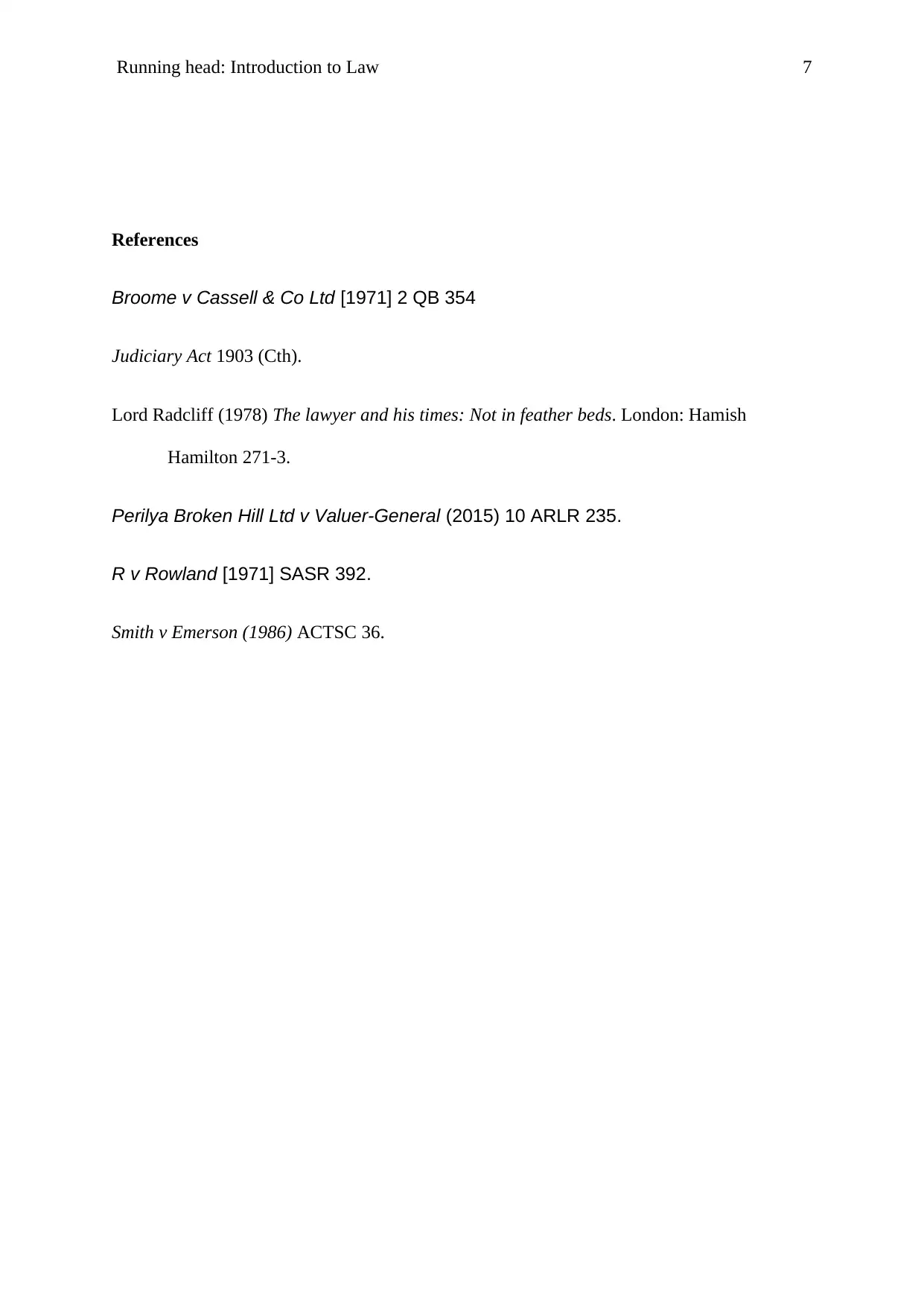
Running head: Introduction to Law 7
References
Broome v Cassell & Co Ltd [1971] 2 QB 354
Judiciary Act 1903 (Cth).
Lord Radcliff (1978) The lawyer and his times: Not in feather beds. London: Hamish
Hamilton 271-3.
Perilya Broken Hill Ltd v Valuer-General (2015) 10 ARLR 235.
R v Rowland [1971] SASR 392.
Smith v Emerson (1986) ACTSC 36.
References
Broome v Cassell & Co Ltd [1971] 2 QB 354
Judiciary Act 1903 (Cth).
Lord Radcliff (1978) The lawyer and his times: Not in feather beds. London: Hamish
Hamilton 271-3.
Perilya Broken Hill Ltd v Valuer-General (2015) 10 ARLR 235.
R v Rowland [1971] SASR 392.
Smith v Emerson (1986) ACTSC 36.
1 out of 7
Related Documents
Your All-in-One AI-Powered Toolkit for Academic Success.
+13062052269
info@desklib.com
Available 24*7 on WhatsApp / Email
![[object Object]](/_next/static/media/star-bottom.7253800d.svg)
Unlock your academic potential
Copyright © 2020–2025 A2Z Services. All Rights Reserved. Developed and managed by ZUCOL.





